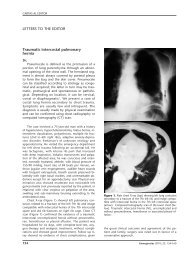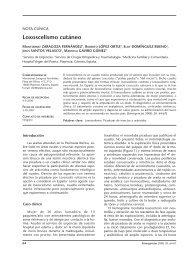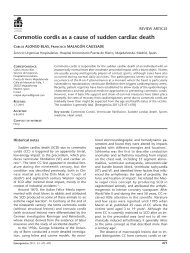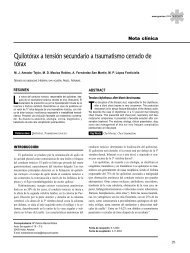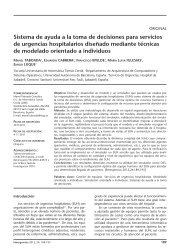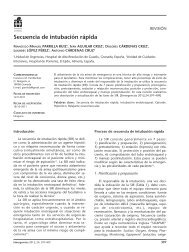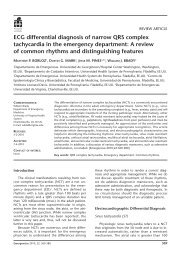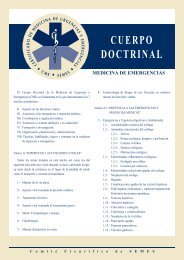Complete text PDF - Semes
Complete text PDF - Semes
Complete text PDF - Semes
Create successful ePaper yourself
Turn your PDF publications into a flip-book with our unique Google optimized e-Paper software.
DIAGNOSTIC AGREEMENT BETWEEN A COMPREHENSIVE, FAST-TRACK COMMUNITY HOSPITAL EMERGENCY DEPARTMENT<br />
We studied the group of patients attended at<br />
our ED and then transferred to the referral hospital<br />
in the year 2009, in order to determine the<br />
degree of agreement between our ED diagnosis<br />
and the definitive discharge diagnosis, and analyzed:<br />
a) the rate of misdiagnosis, b) possible relationship<br />
between misdiagnosis and epidemiological<br />
variables, c) the primary reasons for error, and<br />
d) possible mortality associated with these errors.<br />
Method<br />
We performed a prospective, observational, cohort<br />
study. The study population consisted of patients<br />
referred from our ED to the reference hospital<br />
during the year 2009. From the emergency<br />
medical history we gathered data on age, sex, origin<br />
of transfer and ED diagnosis. We then compared<br />
this diagnosis with that in the report from<br />
the referral hospital concerned. The diagnoses<br />
were coded according to International Classification<br />
of Diseases, 9th Edition, Clinical Modification.<br />
We considered diagnostic agreement as being the<br />
same diagnosis or, if not exactly the same, the<br />
syndrome was correctly identified, requiring action<br />
and/or tests not available at our hospital. Otherwise,<br />
the diagnosis was considered erroneous. In<br />
cases of misdiagnosis, we reviewed in detail the<br />
medical history and laboratory tests to determine<br />
if the reason for the error lay primarily in: a) inadequate<br />
clinical assessment (background, symptoms<br />
or signs, physical examination), b) radiological interpretation,<br />
c) laboratory analytical interpretation)<br />
electrocardiographic interpretation (in this group<br />
we analyzed cases to assess the impact of such interpretation<br />
on the treatment administered).<br />
We compared the variables analyzed for the<br />
group with and without diagnostic agreement.<br />
Descriptive analysis was performed using univariate<br />
and multivariate binary logistic regression.<br />
Results<br />
During the study period, a total of 50,461<br />
emergency patients were attended; 1,598 (3.2%)<br />
were transferred, of whom 1,494 (93%) were<br />
transferred. The remaining 104 patients were<br />
mainly those who used their own means and subsequently<br />
consulted a specialist (ophthalmology,<br />
otolaryngology and pediatrics), but also those erroneously<br />
identified (mainly foreigners) and patients<br />
who ultimately decided not to attend the<br />
referral hospital. The reasons for transfer were to<br />
undergo specialized assessment and/or other diagnostic<br />
tests (imaging tests, invasive procedures<br />
or specific analytical microbiology).<br />
The mean age was 41.6 ± 30.0 years, 56%<br />
were male. As for the origin of transfer, the ED<br />
transferred 1,359 (91%) and the multi-purpose<br />
area 135 (9%). Diagnostic groups were distributed<br />
as follows: trauma 403 (27%), internal<br />
medicine 386 (25.8%), surgery 302 (20.2%), pediatrics<br />
145 (9.7%), gynecology 118 (7 9%), ophthalmology<br />
104 (7%) and otolaryngology 36<br />
(2.4%). There was diagnostic agreement in 1,372<br />
(91.8%) of the cases (87.2% coincided and<br />
12.8% had correct identification of the syndrome),<br />
and 122 (8.2%) discordant diagnoses.<br />
The reasons for diagnostic error were inadequate<br />
clinical assessment in 85 cases (69.7%), radiological<br />
interpretation in 26 (21.3%), analytical interpretation<br />
in 7 (5.7%) and electrocardiographic interpretation<br />
in 4 (3.3%) cases.<br />
Table 1 lists the most common discordant diagnoses,<br />
grouped according to type of error.<br />
There were no deaths in this group of patients<br />
without diagnostic agreement.<br />
Univariate analysis of the groups with and<br />
without diagnostic agreement is shown in Table<br />
2. The group without diagnostic agreement was<br />
younger, most commonly referred from the ED,<br />
and belonging to the pediatric diagnostic group.<br />
Table 1. Most frequent suspected diagnoses categorized according to reasons for error in the 122 patients without final diagnostic<br />
agreementwith the referral hospital<br />
Error in clinical assessment Radiological error Analytical error ECG error<br />
N = 85 (69,7%) N = 26 (21,3%) N = 7 (5,7%) N = 4 (3,3%)<br />
Soft tissue injury (11) Limb fracture (19) Respiratory infection (2) Arrhythmias (4)<br />
Infection in children (7) Vertebral fracture (3) Miscellaneous (5)<br />
Acute abdomen (6)<br />
Upper gastrointestinal bleeding (4)<br />
Acute coronary syndrome (4)<br />
Gastrointestinal disorders in children (4)<br />
Stroke (3)<br />
Ear disease (3)<br />
Miscellaneous * (43)<br />
Miscellaneous (4)<br />
*By specialties: surgery (12), internal medicine (8), pediatrics (7), ophthalmology (7), trauma (3), gynecology (3) otolaryngology (3). ECG: electrocardiography.<br />
Emergencias 2010; 22: 282-285 283



